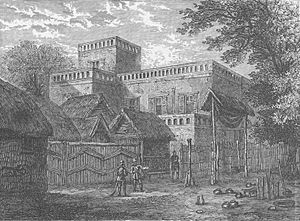Osei Bonsu facts for kids
Quick facts for kids Osei Bonsu |
|
|---|---|
| Asantehene of Asanteman; Kumasehene of Kumasi | |
| King of the Ashanti Empire | |
| Reign | 1804 – 1824 |
| Coronation | 1804 |
| Predecessor | Opoku Fofie |
| Successor | Osei Yaw Akoto |
| Born | 1779 Kumasi, Ashanti Empire |
| Died | 1824 Kumasi, Ashanti Empire |
| House | House of the Oyoko Dynasty |
Osei Bonsu (born 1779 – died 1824) was a powerful king of the Ashanti Empire. He was known as the Asantehene, which means "King of the Ashanti." His full name was Osei Tutu Kwame. He ruled from 1804 to 1824.
During his time as king, the Ashanti fought against the Fante people. They won these battles and gained control over trade in the region, which was then called the Gold Coast. In the Akan language, "Bonsu" means "whale." This name showed how powerful he was, like the biggest creature in the sea. It also showed how he expanded the Ashanti Empire all the way to the coast. Osei Bonsu died in Kumasi, and his successor was Osei Yaw Akoto.
He also led wars against the Fante in 1806–07 and against Gyaman in 1818–19. He helped stop the British from expanding too much in the Gold Coast area.
Contents
Osei Bonsu's Reign
Osei Bonsu was a very active ruler. He supported the creation of a historical record about the ruling Oyoko dynasty. This record was written in Arabic by Muhammad al-Mustafa.
Building Projects
Osei Bonsu was interested in English architecture. In the early 1800s, he started building the Aban Palace. This project was paid for by the public money. He also planned a new layout for the city of Kumasi. Houses along the main road, which connected the areas of Bantama and Asafo, were rebuilt.
He also had workers build a wide, straight road from Kumasi to the village of Breman. His plan was to move people from nearby villages to live along this new road.
In 1816, the King began rebuilding some of the main roads. These roads were made wider (about 30-40 feet) and straighter. Work on the 7th Great Road went well. By 1820, this road, which led to Elmina, was the fastest way to reach the coast from Ashanti. It took only one day to travel.
Education and Culture
Osei Bonsu welcomed educated Muslims into the Ashanti government. These Muslims came from northern areas like Gonja, Dagomba, and Mamprussi. A Muslim school was set up in Kumasi by Al-Ghamba, the leader of the Muslim community. King Bonsu sent some of his own children to this school. By 1819, the school had 70 students. Bonsu supported the school as a sign of respect for the Muslim community.
Ashanti Military
Osei Bonsu also used "Arab medical staff" in the Ashanti army. Their job was to keep records of Ashanti soldiers who were injured or died in battles. This group was used in a campaign against the Fante states in 1807.
Important Battles
One major conflict started when a relative of a chief was accused of grave robbery. The Ashanti court ordered him to pay money, but he attacked the victim instead. Osei Bonsu sent messengers to try and solve the problem peacefully. However, the messengers were killed. This led Osei Bonsu to lead his army against the chief.
The chief and another rebellious leader found safety among the Fante people. Osei Bonsu sent more messengers to the Fante to ask for these people to be handed over. But the Fante killed these messengers too. This led to the Ashanti–Fante War in 1806. By May 1806, the Fante state of Abora was defeated by the Ashanti army. The rebellious leaders then fled to Cape Coast.
In June 1807, the Dutch fort at Kormantin surrendered to the Ashanti. A British fort at Anomabu gave shelter to Fante people escaping the Ashanti invasion. The Ashanti army attacked this fort, and it also surrendered. British records show that many Fante people were killed during this invasion. The Fante leaders who survived promised loyalty to the Asantehene. Osei Bonsu made it clear that he had no problem with the Europeans. He only attacked the fort because it protected his enemies. King Bonsu and the British governor settled their differences in a meeting on June 25.
Later, the province of Gyaman rebelled against Ashanti rule in 1811. After talks failed, the Ashanti leaders decided to send the army to Gyaman again. Asantehene Bonsu led this invasion from 1818 to 1819. The Gyaman cavalry fought strongly, but the Ashanti conquered the state by 1818. From then on, the Ashanti government made sure its rule in Gyaman was strong.
Foreign Relations
After the Ashanti conquered the Fante states by 1816, they controlled the coast of modern Ghana. This made European diplomats interested in visiting Osei Bonsu's court. They wanted to improve relations with the powerful Ashanti Empire. Between 1816 and 1820, many European visitors came to the Ashanti court. These included Willem Huydecoper, Thomas Edward Bowdich, and Joseph Dupuis.



